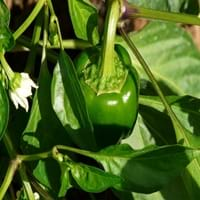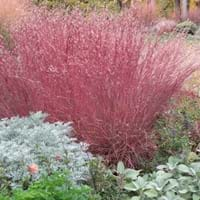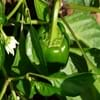Life Span
Perennial
Annual
Origin
Mexico, Central America, South America
North America, United States, Northeastern United States, Mid-Atlantic United States, Southeastern United States, North-Central United States, Central United States, South-Central United States, Southwestern United States, Mexico
Types
Habanero, sweet and chilli paper, Jalapeno, Cayenne pepper
Greener Pastures
Number of Varieties
Not Available
Habitat
Warm and moist climatic conditions, Warmer regions
Grassland
USDA Hardiness Zone
Not Available
4-9
AHS Heat Zone
12-1
10 - 3
Sunset Zone
A1, A2, A3, H1, H2, 1a, 1b, 2a, 2b, 3a, 3b, 4, 5, 6, 7, 8, 9, 10, 11, 12, 13, 14, 15, 16, 17, 18, 19, 20, 21, 22, 23, 24
1a, 1b, 2a, 2b, 3a, 3b, 4, 5, 6, 7, 8, 9, 10, 11, 12, 13, 14, 15, 16, 17, 18, 19, 20, 21, 22, 23, 24
Habit
Oval or Rounded
Clump-Forming
Flower Color
White
Purple
Flower Color Modifier
Bicolor
Bicolor
Fruit Color
Red, Green
Not Available
Leaf Color in Spring
Pale Green
Light Green
Leaf Color in Summer
Green
Light Green
Leaf Color in Fall
Green, Black
Red, Purple
Leaf Color in Winter
Not Available
Tan
Leaf Shape
Elliptic
Grass like
Plant Season
Spring, Summer, Fall
Summer, Fall, Winter
Sunlight
Full Sun
Full Sun, Partial Sun
Type of Soil
Loam
Loam, Sand
The pH of Soil
Neutral
Acidic, Neutral, Alkaline
Soil Drainage
Well drained
Well drained
Bloom Time
Indeterminate
Late Summer, Early Fall
Tolerances
Drought
Drought
Where to Plant?
Container, Ground, Pot
Ground
How to Plant?
Seedlings
Divison, Seedlings
Plant Maintenance
Medium
Medium
Watering Requirements
Requires regular watering, Water frequently while growing
Medium
In Summer
Lots of watering
Lots of watering
In Spring
Moderate
Moderate
In Winter
Average Water
Average Water
Soil pH
Neutral
Acidic, Neutral, Alkaline
Soil Type
Loam
Loam, Sand
Soil Drainage Capacity
Well drained
Well drained
Sun Exposure
Full Sun
Full Sun, Partial Sun
Pruning
Remove damaged leaves, Remove dead branches, Remove dead leaves
Remove damaged leaves, Remove dead branches, Remove dead leaves
Fertilizers
All-Purpose Liquid Fertilizer
All-Purpose Liquid Fertilizer
Pests and Diseases
Beetles, Cutworms, Insects
Red blotch
Plant Tolerance
Drought
Drought
Flowers
Insignificant
Showy
Flower Petal Number
Single
Single
Foliage Texture
Medium
Fine
Foliage Sheen
Glossy
Matte
Attracts
Beetles, Bugs, Cutworms, Insects
Butterflies
Allergy
allergic reaction, Anaphylaxis, Eczema, gastro-intestinal problems, Mouth itching, Nose Irritation, Oral Allergy, Runny nose, Skin rash, sneezing, Tingly mouth
Not Available
Aesthetic Uses
Not Used For Aesthetic Purpose
Showy Purposes
Beauty Benefits
Not Available
Not Available
Environmental Uses
Air purification
Air purification
Medicinal Uses
anti-inflammatory, Anti-oxidant, Low calories, Soothing and relieving pain, ß-carotene, Vitamin C, Vitamin E
Not Available
Part of Plant Used
Fruits, Leaves, Seeds
Leaves, Root
Other Uses
Condiment
Showy Purposes
Used As Indoor Plant
Sometimes
No
Used As Outdoor Plant
Yes
Yes
Garden Design
Container, Edible, Herb / Vegetable
Cutflower, Dried Flower/Everlasting, Groundcover, Mixed Border, Rock Garden / Wall
Botanical Name
CAPSICUM annuum 'Better Belle Hybrid Improved'( Grossum Group)
ERAGROSTIS spectabilis
Common Name
Bell Pepper, Sweet Pepper
Purple Lovegrass
In Hindi
Shimla mirch
eragrostis spectabilis
In German
Paprika
eragrostis spectabilis
In French
Capsicum
eragrostis spectabilis
In Spanish
Capsicum
Eragrostis spectabilis
In Greek
γλυκό πιπέρι
eragrostis spectabilis
In Portuguese
Capsicum
Eragrostis spectabilis
In Polish
Papryka
Eragrostis okazałe
In Latin
Capsicum
Eragrostis spectabilis
Phylum
Vascular plant
Magnoliophyta
Class
Magnoliopsida
Liliopsida
Order
Solanales
Cyperales
Family
Solanaceae
Poaceae
Clade
Angiosperms, Asterids, Eudicots
Angiosperms, Commelinids, Monocots
Tribe
Capsiceae
Eragrostideae
Subfamily
Solanoideae
Chloridoideae
Number of Species
Not Available
Importance of Sweet Pepper and Purple Lovegrass
Want to have the most appropriate plant for your garden? You might want to know the importance of Sweet Pepper and Purple Lovegrass. Basically, these two plants vary in many aspects. Compare Sweet Pepper and Purple Lovegrass as they differ in many characteristics such as their life, care, benefits, facts, etc. Every gardener must at least have the slightest clue about the plants he wants to plant in his garden. Compare their benefits, which differ in many ways like facts and uses. The medicinal use of Sweet Pepper is anti-inflammatory, Anti-oxidant, Low calories, Soothing and relieving pain, ß-carotene, Vitamin C and Vitamin E whereas of Purple Lovegrass is Not Available. Sweet Pepper has beauty benefits as follows: Not Available while Purple Lovegrass has beauty benefits as follows: Not Available.
Compare Facts of Sweet Pepper vs Purple Lovegrass
How to choose the best garden plant for your garden depending upon its facts? Here garden plant comparison will help you to solve this query. Compare the facts of Sweet Pepper vs Purple Lovegrass and know which one to choose. As garden plants have benefits and other uses, allergy is also a major drawback of plants for some people. Allergic reactions of Sweet Pepper are allergic reaction, Anaphylaxis, Eczema, gastro-intestinal problems, Mouth itching, Nose Irritation, Oral Allergy, Runny nose, Skin rash, sneezing and Tingly mouth whereas of Purple Lovegrass have Not Available respectively. Having a fruit bearing plant in your garden can be a plus point of your garden. Sweet Pepper has showy fruits and Purple Lovegrass has no showy fruits. Also Sweet Pepper is not flowering and Purple Lovegrass is not flowering . You can compare Sweet Pepper and Purple Lovegrass facts and facts of other plants too.





